-
Engine4.0L Flat-6
-
Power414 HP / 309 LB-FT
-
Transmission6-Speed Manual
-
0-60 Time4.2 Seconds
-
DrivetrainRWD
-
Engine PlacementMid
-
Curb Weight3,199 LBS
-
Seating2
-
MPGNot Available
-
Base Price$100,450
FIFE, Scotland — Knockhill Racing Circuit is a charming wee track in the middle of Scotland. It's 1.3 miles long with nine turns traversing the hilly land surrounding the eponymous, sheep-dotted Knockhill. The three mighty bridges crossing the Firth of Forth loom in the distance. The Porsche resident racing drivers on hand aptly describe the track as a roller coaster – it's absolutely perfect for the 2020 Porsche 718 Cayman GT4.
After a trio of get-to-know-you laps, speeds rapidly rise while chasing a pro in a GT3 RS. The circuit is easy to remember and well-suited to the GT4’s strengths, which allow it to flick through corners cleanly and quickly. It's the kind of car that can make you feel awfully good about yourself.
Like every 718, the GT4’s mid-mounted 4.0-liter flat-six gives it an inherent balance. It rotates as freely as a compass needle, with you at its center. But the GT4’s suspension adds to the 718’s inherent talents. Up front is the same setup as the 2018 GT3 RS, which also donates certain elements (subframe, control arms, shocks) to an otherwise unique suspension design. The ride height is also reduced by 1.8 inches, and the PASM adaptive dampers were specially tuned for the GT4. (As I discovered with its identical setup in the 718 Spyder, it's refreshingly not unusable away from the track.)
The gap in compliance between Normal and Sport modes is small. In fact, it can be beneficial to keep the car in Normal given the ideal line at Knockhill repeatedly takes you over the sizable blue-striped curbs. The photo showing the GT4 on two wheels is not just for show. The two mid-corner blind crests make things plenty interesting as well, yet there's never a clenching moment. The GT4 is a masterpiece of composure. Even when sliding ever so slightly, it does so feeling like all four wheels are moving laterally. Grip and control are easily reacquired. There's that mid-engine balance again, but let's also not discount the stability control, which remained on yet never felt like it was snatching away control.
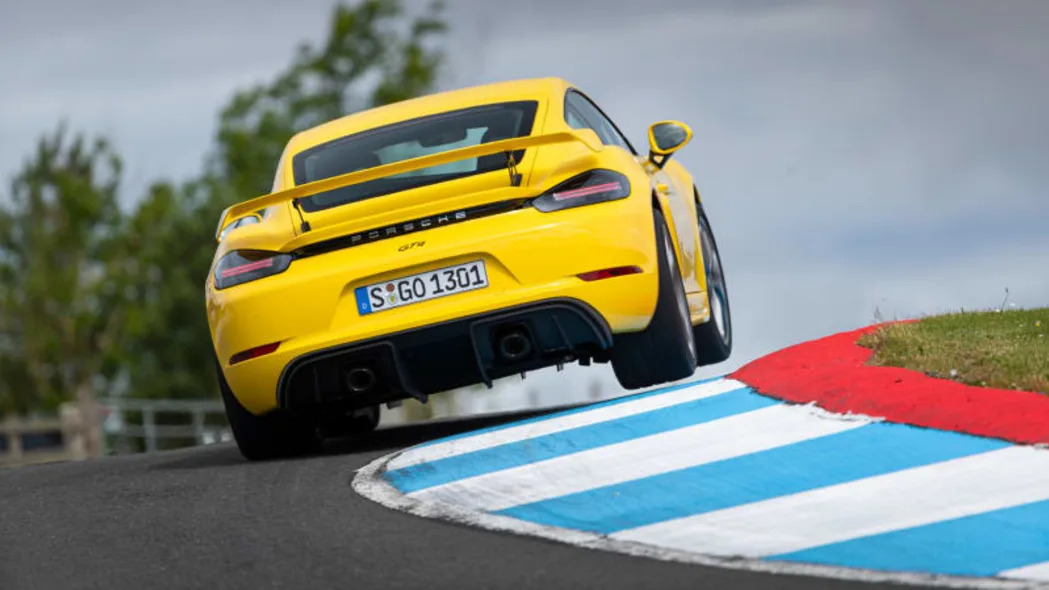
Yet, credit for the GT4's even greater corner-taking speed goes to the full aerodynamic regimen. The most obvious element is the fixed rear wing, unique to the GT4, which provides 20% more downforce than the one fitted to the old GT4. That corresponds to an extra 26.5 pounds at 124 mph (200 km/h). However, the new GT4 actually generates 50% extra downforce in general compared to its predecessor thanks to a substantial diffuser that sucks the car to the pavement. It's refreshingly subtle in appearance, and it's pretty cool that Porsche engineered the twin-port exhaust system's silencer in a saddle shape so that it could arch over the diffuser's massive central channel.
There's also the center aero duct forward of the frunk lid, long a trait of Porsche GT cars, plus channels that guide air around the front wheels, and an enlarged front splitter that features a golfball-like surface to reduce drag. That speaks to the efforts made to make sure drag in general remained virtually unchanged despite the dramatic increase in downforce.
On a rollercoaster track like Knockhill, the brakes are going to get a workout, and to that end the GT4 and Spyder inherit those of the GT3. The standard cast iron rotors are 14.96 inches front and rear, and feature aluminum Monobloc fixed calipers (six-piston front, four-piston rear) painted a standard red finish. The optional ceramic composite brakes are 16.1 inches front, 15.35 inches rear, and can be identified by their yellow calipers (six-piston front, four-piston rear). They're 50% lighter than the standard iron rotors, which does as much for reducing unsprung mass and further improving agility as it does improving stopping power and reducing fade. Both braking systems are enveloped in 20-inch wheels with ultra-high-performance Michelin tires (245/35 ZR front, 295/30 ZR rear).
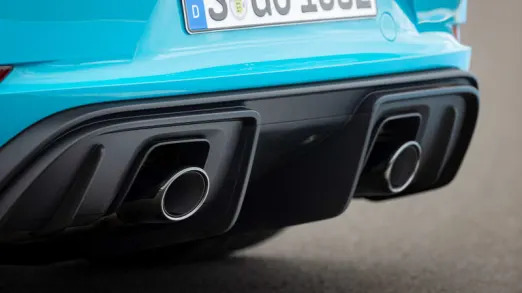

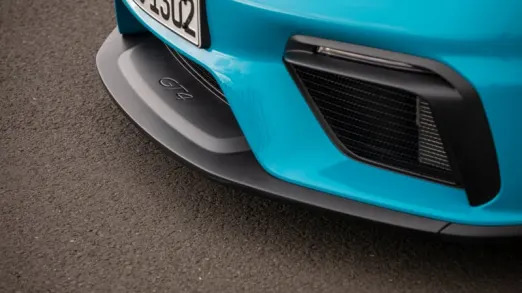

For much of Knockhill, the GT4 stays in third. I should probably upshift to fourth on the short straight heading into turn 7, but I'd have to almost immediately downshift again, I'm not laying down a lap time, and besides, there's absolutely nothing wrong with letting the 4.0-liter flat-six sit near its 8,000-rpm redline for an extra second or two.
This naturally aspirated engine, derived from the 911's turbocharged flat-six family, is the answer to all of those who lament Porsche's mid-engined cars switching to turbo flat-fours. It produces 414 horsepower (versus 365 in the 718 Cayman GTS) and even matches the turbo cars' torque at 309 pound-feet. That it achieves it at 5,000 rpm versus 1,900-4,500 results in a profoundly different, more linear power delivery better suited to such a balanced, forgiving car as the 718. It also sounds sensational, with a raw, mechanical wail that doesn't need to rely on that dual-port exhaust for any extraneous audible histrionics. In fact, the difference between the sport exhaust's normal and loud settings is difficult to detect.
Controlling this peach of an engine is delightful manual – a rare species these days – although a PDK dual-clutch automatic will eventually be available, and it'll likely result in improved 0-60 and lap times. However, this six-speed manual is mindlessly easy to operate, yet still abundantly rewarding. The shift knob is shorter than the standard 718's, further improving upon its compelling snick-snick action. Throttle response is so good it doesn’t need multiple settings, thanks in part to its zingy engine. The dual-mass flywheel makes it easy for your left leg (admittedly more of a boon in normal driving), but its precision and ease of engagement are faultless.
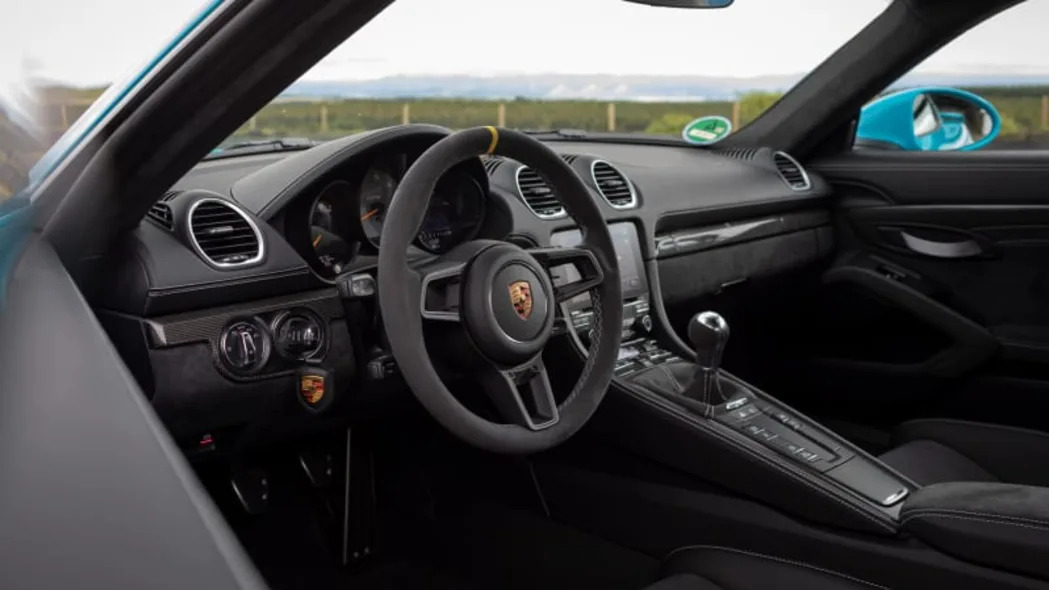
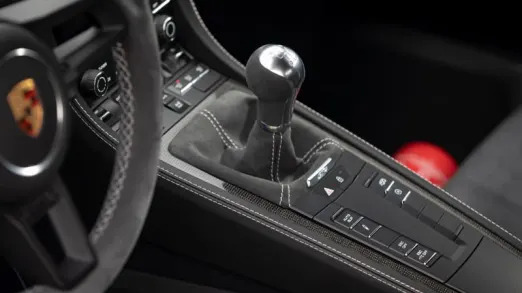
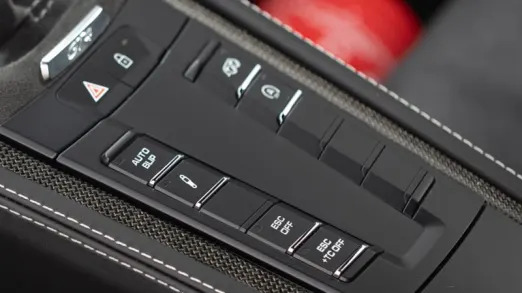
Finally, and probably most important to the point at hand, there's the Cayman GT4's new Auto Blip function that betters other rev-matching downshift functions with its immediacy and smoothness. It actually feels an awful lot like downshifting with PDK. There will be plenty of people who'll prefer to turn off Auto Blip and heel-toe downshift by pressing a dedicated button, which is fine, but on a track, an errant heel-toe application can result in a cascade of mistakes (a loss of time, a missed line, embarrassingly over-revving the engine).
Now, to make up for the fact that the GT4 has an extra pair of cylinders, the 4.0-liter features automatic cylinder deactivation that allows it to operate with three cylinders at engine speeds between 1,600 and 3,000 rpm. Though it definitely didn't come on at Knockhill, it would have during my road drive of the Spyder, yet it was never noticed. The auto stop/start function is also well executed.
I mention this fuel-saving business not as a diversion from the track, but to emphasize that this track-oriented car is just as easily at home out on real roads. If anything, its fixed roof makes it more sensible than the mostly mechanically identical (and only 7-pounds heavier) Spyder with its slinky but functionally challenged soft top. The GT4 isn’t as visually distinctive as the Spyder when compared to their respective 718s, making it a bit of a sleeper. Those who notice the rear wing and diffuser, the enlarged side intakes, and the interior's strap door handles will know what's up. You have the most desirable Cayman, period.
You also have one of the most desirable cars for driving on a track, period. It's wildly capable, wickedly fast, and perhaps best of all, couldn't be easier and more forgiving. Porsche's other GT cars are obviously capable of greater speed, but they also start at $43,000 more than the Cayman GT4 at $100,450. That GT3 RS hits the register at $187,500. Breaking the six-digit mark for a 718 may seem shocking, but given what it can do on and off a track, it really isn't.
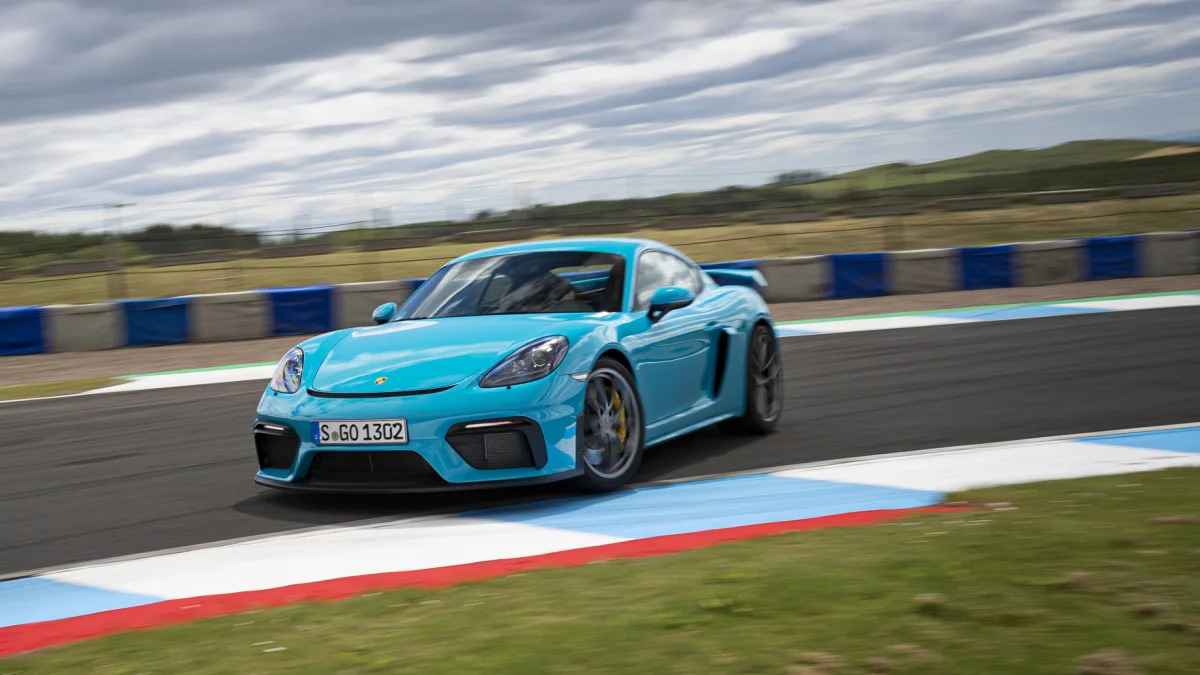








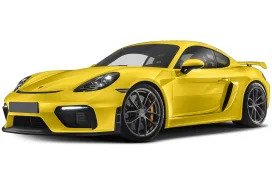



Sign in to post
Please sign in to leave a comment.
Continue